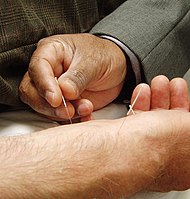
Photo from wikipedia
Objective To analyze the effect of acupuncture versus hormone replacement therapy (HRT) for premature ovarian insufficiency (POI). Methods China National Knowledge Infrastructure (CNKI), Wanfang Academic Journal Full-text Database (Wanfang), Chongqing… Click to show full abstract
Objective To analyze the effect of acupuncture versus hormone replacement therapy (HRT) for premature ovarian insufficiency (POI). Methods China National Knowledge Infrastructure (CNKI), Wanfang Academic Journal Full-text Database (Wanfang), Chongqing VIP Database (CQVIP), China Biology Medicine Disc (CBM), Web of Science, Cochrane Library, PubMed, and Excerpta Medica Database (EMBASE) were searched up to January 31st, 2019 to identify randomized controlled trials (RCTs) evaluating the effect of acupuncture for POI. The primary outcome was the level of basal serum follicle-stimulating hormone (FSH). Secondary outcomes included serum levels of luteinizing hormone (LH), estradiol (E 2 ) and anti-Müllerian hormone (AMH). Two authors extracted data independently and assessed the risk of bias and the methodological quality using the Cochrane’s tool. Meta-analysis was conducted by RevMan version 5.3. Results Eight eligible RCTs with a total of 496 POI patients were included in the meta-analysis. The pooled results showed that there was a significant reduction in the basal serum FSH level (MD=−5.82, 95%CI: −9.76 to −1.87, I 2 =82%, P =0.004) and a remarkable elevation in the basal E 2 level (SMD=0.93, 95%CI: 0.34 to 1.52, I 2 =88%, P =0.002) in the acupuncture group when compared with the control. Subgroup analysis showed that compared with HRT, a significant decrease in the FSH level was observed in both acupuncture alone (MD=−4.53, 95%CI: −8.96 to −0.10, I 2 =73%, P =0.04) and acupuncture plus HRT (MD=−9.60, 95%CI: −17.60 to −1.61, I 2 =50%, P =0.02), while a remarkable elevation of E 2 was only found in acupuncture plus HRT (SMD=1.43, 95%CI: 1.03 to 1.82, I 2 =0%, P <0.00001). There was no significant difference in the LH level between acupuncture and HRT (MD=−3.16, 95%CI: −9.41 to 3.10, I 2 =0%, P =0.32), only one trial reported AMH, and no significant difference was found between acupuncture and HRT. Conclusion The present study indicated that acupuncture had an advantage over HRT in reducing serum FSH level and increasing serum E 2 level in women with POI. However, evidence supporting the finding is limited due to the small sample size, potential methodological flaws and significant heterogeneity. Hence, this conclusion still needs to be verified by high-quality RCTs. 目的 分析与激素替代疗法(HRT)相比, 针刺治疗早发性卵巢功能不全(POI)的临床疗效. 方法 计算机检索中国知网(CNKI)、 万方学术期刊全文数据库(Wanfang)、 重庆维普数据库(CQVIP), 中国生物医学文献数据库(CBM), 科学网、 Cochrane图书馆, PubMed及荷兰医学文摘(EMBASE)数据库, 收集发表于2019年1月31日前的针刺治疗POI的随机对照试验(RCTs). 主要疗效指标为血清基础促卵泡生成素(FSH)水平; 次要指标包括血清黄体生成素(LH), 雌二醇(E 2 )和抗缪勒管激素(AMH)水平. 两名作者独立提取数据, 使用Cochrane评测工具评估偏倚和文献质量. 采用RevMan 5.3对纳入文献进行Meta分析. 结果 共纳入8篇RCTs, 包含496例POI患者. Meta分析显示, 与对照组相比, 针刺可显著降低血清基础FSH水平[MD=‒5.82, 95%CI (‒9.76,‒1.87), I 2 =82%, P =0.004], 升高E 2 水平[SMD=0.93,95%CI (0.34, 1.52), I 2 =88%, P =0.002]. 亚组分析显示, 与对照组相比, 单纯针刺[MD=‒4.53, 95%CI (‒8.96,‒0.10), I 2 =73%, P =0.04]和针刺联合HRT[MD=‒9.60, 95%CI (‒17.60,‒1.61), I 2 =50%, P =0.02]均能显著降低FSH水平, 但只有针刺联合HRT可显著升高E 2 水平[SMD=1.43, 95%CI (1.03, 1.82), I 2 =0%, P <0.00001]. 针刺与HRT之间LH水平无明显变化[MD=‒3.16, 95%CI (‒9.41, 3.10), I 2 =0%, P =0.32], 纳入文献中只有1篇报告了AMH, 结果显示针刺和HRT对AMH的改善无显著差异. 结论 针刺可显著降低POI患者血清FSH水平, 升高E2水平. 然而, 由于纳入文献存在样本量小、 研究方法存在缺陷及显著的异质性等问题, 支持研究结论的证据有限. 因此, 本研究结论仍需高质量的RCT加以验证.
Journal Title: Journal of Acupuncture and Tuina Science
Year Published: 2020
Link to full text (if available)
Share on Social Media: Sign Up to like & get
recommendations!